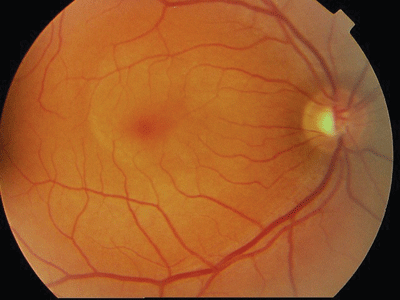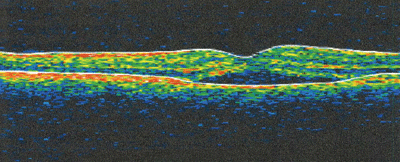|
|
Q: I have a middle-aged male patient who has idiopathic central serous retinopathy. Interestingly, he doesnt seem to have the typical type-A personality and says he has no particular stress in his life. What else could cause this?
A: Since you mention no other information, you may want to question the patient further. For instance, an unusual case of idiopathic central serous retinopathy was referred to us here at Omni Eye Services in Atlanta. This patient was a 40-year-old white male but, unlike the typical patient with idiopathic central serous retinopathy, he reported no stress and he wasnt a type-A person.
The optometrist who referred him had examined him the same morning. At that visit, the patient reported a rapid decrease in vision in his right eye. He described a progressive spot that had been reducing vision in that eye for the previous two days.
His past records revealed 20/20 uncorrected vision in both eyes with no prior injuries or surgeries, says resident in ocular disease Michael Johnson, O.D., who saw the patient at Omni. Upon examination this time, the patients best-corrected visual acuity was 20/200 O.D. and 20/20 O.S.
He said the spot in his vision began within a few hours after he was welding, Dr. Johnson says. Although the patient said he normally wears eye protection, he did not wear goggles this particular time.
Pinhole acuity showed no improvement in the right eye. Confrontation visual fields were full to finger counting O.U.
Slit lamp biomicroscopy revealed healthy anterior segments O.U. Amsler grid showed a sub-central relative scotoma in the patients right eye. Dilated fundus examination with a 90D lens showed macular edema O.D. with loss of foveal light reflex.
The macular edema was an oval pattern located superior to the fovea with outlined borders, Dr. Johnson says.
Optical coherence tomography of the right eye showed foveal macular edema with a serous retinal detachment. Fluorescein angiography confirmed central serous retinopathy.
 |
 |
|
Fundus exam (above) showed macular edema in the right eye with loss of foveal light reflex. Optical coherence tomography (below) showed foveal macular edema with a serous retinal detachment. |
Could this [retinopathy] possibly be related to a welding injury? Dr. Johnson wondered.
So, he researched it. Eye injuries account for one in four workers compensation claims made by welders, he discovered.1 Nearly all welding injuries occur to the front of the eye. And, most of these (72%) are due to projectile foreign bodies or burns (22%).1 So welding eye injuries are very common, Dr. Johnson says. But welding eye injuries that affect the retina are very uncommon.
However, a few documented cases have been reported in which the optical radiation from welding resulted in retinopathy, even in a case in which the welder wore eye protection.2-4
Welding emits optical radiation from the ultraviolet (UV) spectrum all the way through the infrared (IR) spectrum, Dr. Johnson says. UV and far-IR radiation are absorbed by the cornea and the lens, while visible light and near-IR radiation penetrate to the retina. This may cause thermal or photochemical retinal damage.3
This patient was using a plasma torch, which is a type of metal inert gas (MIG) welding, Dr. Johnson says. Another name for it is gas metal arc welding. This particular type of welding produces a higher and more intensified concentration of near-IR than conventional welding.3
Its the near-infrared and short-wavelength visible light [blue light] that can penetrate the retina and cause inflammation, he says. When inflammation occurs, youve got a breakdown of the retinal pigment epithelium, which leads to leakage and development of maculopathy.
This patient should likely receive the same treatment as any other case of central serous retinopathy, says optometrist Jeffry Gerson, who practices in a retinal referral practice in Overland Park, Kan. Usually, the treatment is observation while the retinopathy resolves on its own, he says. Once fluorescein angiography (FA) has been done to confirm that there is no choroidal neovascular membrane, watch and monitor the patient monthly, unless he reports any changes before then, Dr. Gerson says. Also, send the patient home with an Amsler grid for self-testing.
The patient in this case received an oral NSAID for the first two weeks. Now, at four months post-injury, the patients visual acuity has improved to 20/50 in the affected eye.
One important note about the idiopathic nature of central serous: Always rule out steroid use as a factor. Even topical [steroid] creams can cause central serous, Dr. Gerson says.
For this particular patient, it would be interesting to obtain indocyanine green (ICG) angiography, Dr. Gerson says. Idiopathic central serous often manifests with several areas of diseased retinal pigment epithelium on ICG that may not be evident on FA. So, if this were truly idiopathic central serous, we would expect multiple defects on ICG. But, if this patients retinopathy was solely due to the welding, then there would likely only be one discrete spot on ICG.
1. Lombardi DA, Pannala R, Sorock GS, et al. Welding related occupational eye injuries: a narrative analysis. Inj Prev 2005 Jun;11(3):174-9.
2. Maculopathy caused by welding arcs. A report of 3 cases. Acta Ophthalmol (Copenh) 1993 Jun;71(3):402-4.
3. Magnavita N. Photoretinitis: an underestimated occupational injury? Occup Med (Lond) 2002 Jun;52(4):223-5.
4. Cellini M, Profazio V, Fantaguzzi P, et al. Photic maculopathy by arc welding. A case report. Int Ophthalmol 1987 Jun;10(3):157-9.


